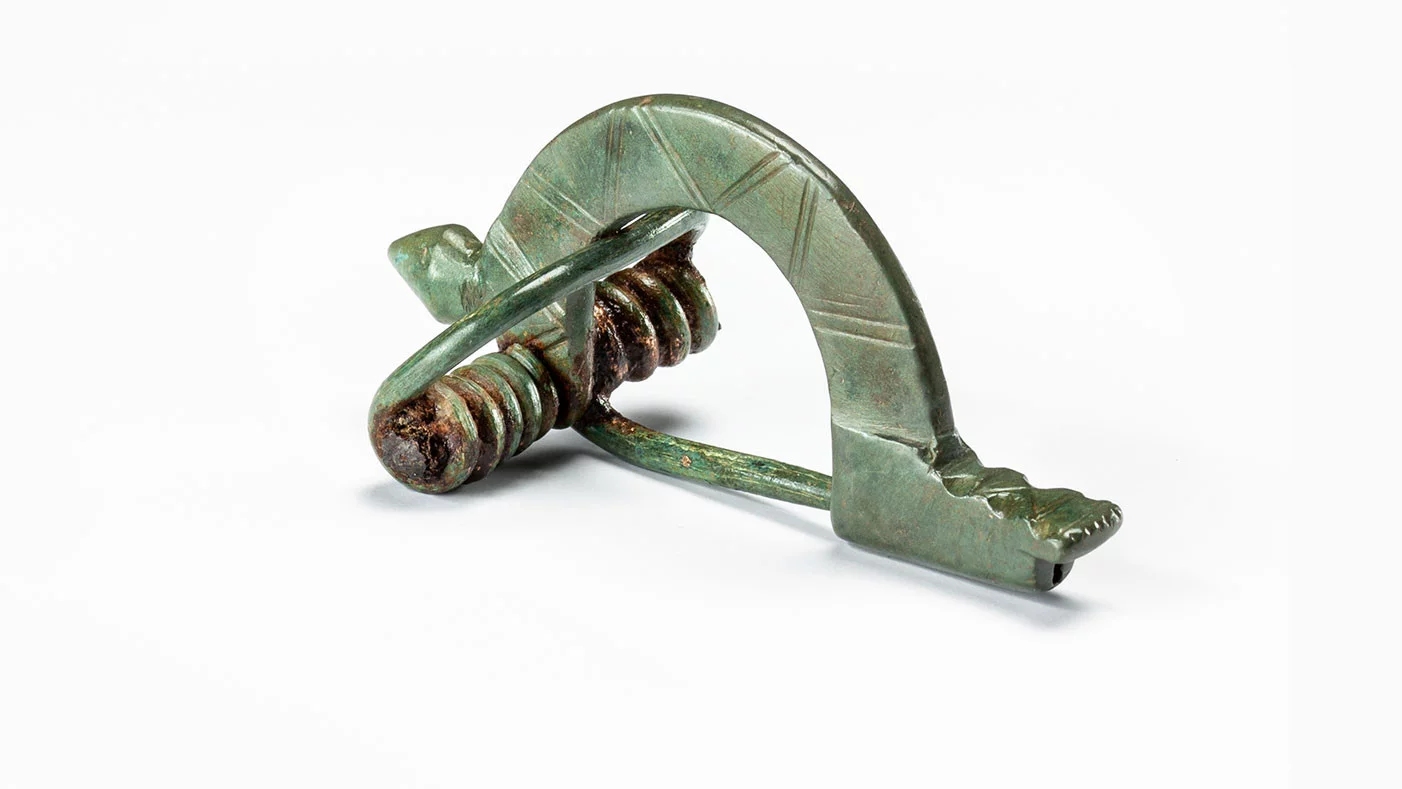Using Muon Induced X-ray Emission, researchers at Paul Scherrer Institute PSI could reveal the inner composition of a knob-bow fibula, excavated in the Roman city of Augusta Raurica in northern Switzerland. The non-destructive technique, which benefits from the most intense continuous muon source in the world, shed light on how the unusual bronze brooch was made.
The elemental composition of ancient artefacts can tell a wealth of information about past civilisations. Yet archaeologists frequently face an excruciating choice of whether to reveal this information and destroy the artefact, or preserve the artefact for generations to see, leaving its stories untold.
The technique of Muon Induced X-ray Emission (MIXE), under development at the Swiss Muon Source SµS, allows a rare opportunity to analyse the chemical composition deep within an object whilst leaving it unharmed.
A Germanic brooch in a Roman fort
One such rare and valuable artefact to benefit from the technique is a bronze brooch known as a knob-bow fibula, excavated in the Roman city, Augusta Raurica, which lies at the present day Swiss city of Kaiseraugst on the border with Germany. The fibula, a type of safety pin, would have been used to fasten garments, such as a cloak. “This very specific type of brooch, the so called “Leutkirch” type, has been found only twenty one times so far. So we wouldn’t want to cut it up!” says physicist Sayani Biswas, who performed the analysis.
Without damaging it, using MIXE, the researchers could reveal that the brooch was made predominantly of copper, zinc, tin and lead. Yet this composition was not uniform throughout the brooch. “We noticed that the spiral part that forms the pin has a much lower lead content than the ornate upper part,” explains Biswas. This led to the conclusion that the brooch was made as two different ‘workpieces’. The higher lead content of the upper part suggests a cast bronze – a method of manufacturing used to create ornate objects. The lower lead contrast of the ‘pin’ part suggests a forged bronze, giving greater durability to the functional part. “This shows that the workmen already knew how the lead content affected the material properties,” says archaeologist Isabel Megatli-Niebel, who is a research associate at the Augusta Raurica settlement.
This shows that the workmen already knew how the lead content affected the material properties
Intriguingly, these workmen were most likely not Romans, but Germans. The knob-bow fibula is a Germanic structure. So, how did it come to be found in a Roman city? “This could be for various reasons. In any case, it proves the active cross-border exchange of goods,” adds Megatli-Niebel.
Muonic X-ray vision
To perform MIXE analysis, a beam of negative muons shines on the sample. These muons can penetrate deep into the material. High energy X-rays are then emitted when muons, captured by the atoms in a sample, cascade to the ground state. The energy of this radiation gives information on the type of atom that captured the muon.
The muon is essentially a heavy electron, with a mass about two hundred times greater. It is this difference in mass that gives the technique its ability to probe deep within a material, where other techniques barely shave the surface. “With traditional techniques, the energy of the X-rays emitted are rather small compared to ours: a factor of about 200 smaller because of the difference between the mass of the electron and the muon. And this means that the X-rays cannot travel through a lot of material - you can only probe close to the surface,” explains Alex Amato, head of the Neutrons and Muons Division, who is leading the development of the technique at PSI.
From priceless artefacts to batteries
Although MIXE was first performed around fifty years ago, the technique is now receiving a resurgence at several muon sources. At PSI, it benefits from the most intense continuous muon beam in the world, which offers distinct advantages to pulsed muon beams found at many other facilities. At pulsed sources, muons come in waves and detectors are quickly overwhelmed, limiting sensitivity. The situation is akin to watering a garden in the summer: heavy thunderstorms might provide a large, sudden rainfall, but plants cannot efficiently absorb the water. Better is regular rainfall. “With the unique experimental set up here, every muon counts. This makes us incredibly sensitive,” adds Amato.
The applications of MIXE go way beyond studying archaeological artefacts. In particular, the technique, which is sensitive to almost all the elements, can be useful for operando-studies of devices such as lithium batteries.
The development of MIXE at PSI is a joint effort between PSI, the Roman settlement of Augusta Raurica, Empa, and the Natural History Museum of Bern, with financial support from the Swiss National Science Foundation, which is providing nearly one and a half million Swiss francs within the framework of the Sinergia Programme. Looking beyond this programme, which ends in 2024, the goal is to establish a user station that would make MIXE available to the wider scientific community.
Text: Paul Scherrer Institute / Miriam Arrell
Further information
Hercules and batteries, X-rayed | NUM | Paul Scherrer Institut (PSI)
MIXE Project | SMUS | Paul Scherrer Institut (PSI)
Contact
Dr. Alex Amato,
Head - NUM Division a.i.,
Paul Scherrer Institute, Forschungsstrasse 111, 5232 Villigen PSI, Switzerland
Telephone: +41 56 310 32 32, email: alex.amato@psi.ch
Original Publication
The non-destructive investigation of a late antique knob bow fibula (Bügelknopffibel) from Kaiseraugst/CH using Muon Induced X-ray Emission (MIXE)
Sayani Biswas, Isabel Megatli-Niebel, Lilian Raselli, Ronald Simke, Thomas Elias Cocolios, Nilesh Deokar, Matthias Elender, Lars Gerchow, Herbert Hess, Rustem Khasanov, Andreas Knecht, Hubertus Luetkens, Kazuhiko Ninomiya, Angela Papa, Thomas Prokscha, Peter Reiter, Akira Sato, Nathal Severijns, Toni Shiroka, Michael Seidlitz, Stergiani Marina Vogiatzi, Chennan Wang, Frederik Wauters, Nigel Warr & Alex Amato
Heritage Science (March 2023)
DOI: 10.1186/s40494-023-00880-0
Copyright
PSI provides image and/or video material free of charge for media coverage of the content of the above text. Use of this material for other purposes is not permitted. This also includes the transfer of the image and video material into databases as well as sale by third parties.

